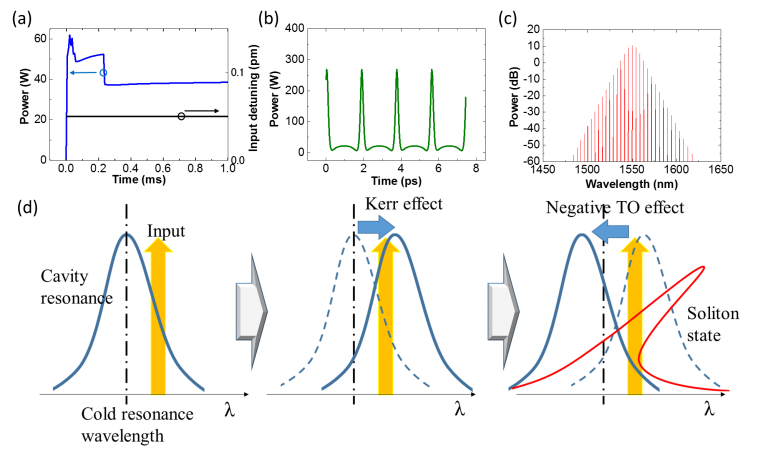Automatic soliton generation using negative thermo-optic effects
Research
Automatic soliton generation using negative thermo-optic effects
Toward the Practical Application of Optical Car-Com
The optical frequency comb, introduced by Hänsch et al. in 1999, has become widely used as a "measure of light" with a comb-shaped spectrum that enables precise optical frequency measurements. This technology won the Nobel Prize in Physics in 2005 and was adopted as the national standard for length in Japan in 2009. In recent years, research on "optical carcoms," in which the generator (resonator) of the optical frequency comb is miniaturized to the micro scale and energy-saving, has been actively conducted. The most stable state of an optical Kercomb is called an optical soliton, and previous research has shown that this state can be obtained by appropriately changing the wavelength of the input light relative to the resonance wavelength. However, there have been few studies that take into account the effect of heat generated by absorption and other factors on the resonance wavelength (thermo-optic effect) when actually generating optical Kercombs.
In this study, we developed a new computational model that takes into account the effect of heat, and in particular, we showed by calculation how to generate optical solitons using negative thermo-optic effects, which had not been considered before.

Fig. 1.(a) Illustration of coupled WGM cavity model.(b) Scheme for simulating Kerr comb generation with the thermal effect.
Fig. 1(a) shows the model used to calculate the generation of an optical Kerr comb. When light is input from a waveguide to a circular resonator, an optical CURCOM is generated in the resonator. Since thermal effects were not taken into account in the previous calculation method, a new calculation model that incorporates thermal effects was constructed by adding the calculation procedure shown in Fig. 1(b).

Fig. 2 (a) The intracavity power (blue line) and the input detuning from the cold cavity resonance (black line), calculated with the CaF2 (b,c) Temporal waveform and optical spectrum of the Kerr comb in the cavity for the stable final state (thermal equilibrium). (d) Illustration of the mechanism of the transition to the soliton state caused by a negative TO effect.
Fig. 2(a) shows the negative thermo-optic effect of CaF2The following figure shows the calculation results when a resonator is used as a model. Fig. 2(a) shows that the light intensity increases sharply after the light input at 0 ms, and then decreases and transitions to the stable state. Fig. 2(b,c) shows the time waveform and optical spectrum of the light in the resonator in this final stable state. The results show that steep pulses (optical solitons) are generated in the resonator and that the spectrum has a beautiful comb-like shape. The mechanism is shown in Fig. 2(d). First, when a wavelength near the resonance wavelength is input, the light is confined within the resonator and its intensity increases rapidly. This causes the resonance wavelength to shift to the longer wavelength side due to the optical Kerr effect. Heat is then generated due to absorption of the light, and the resonance wavelength is shifted to the short wavelength side due to the negative thermo-optic effect. This change in resonance wavelength due to the thermo-optic effect is practically equivalent to changing the input wavelength to the longer wavelength side, which is a known soliton generation method, and is the principle of soliton generation.
This achievement shows that solitons can be generated automatically without changing the input wavelength of the light source as in the past, and is expected to be one of the simpler and more practical ways to generate optical carcoms.
- Categories
- 研究トピックス



